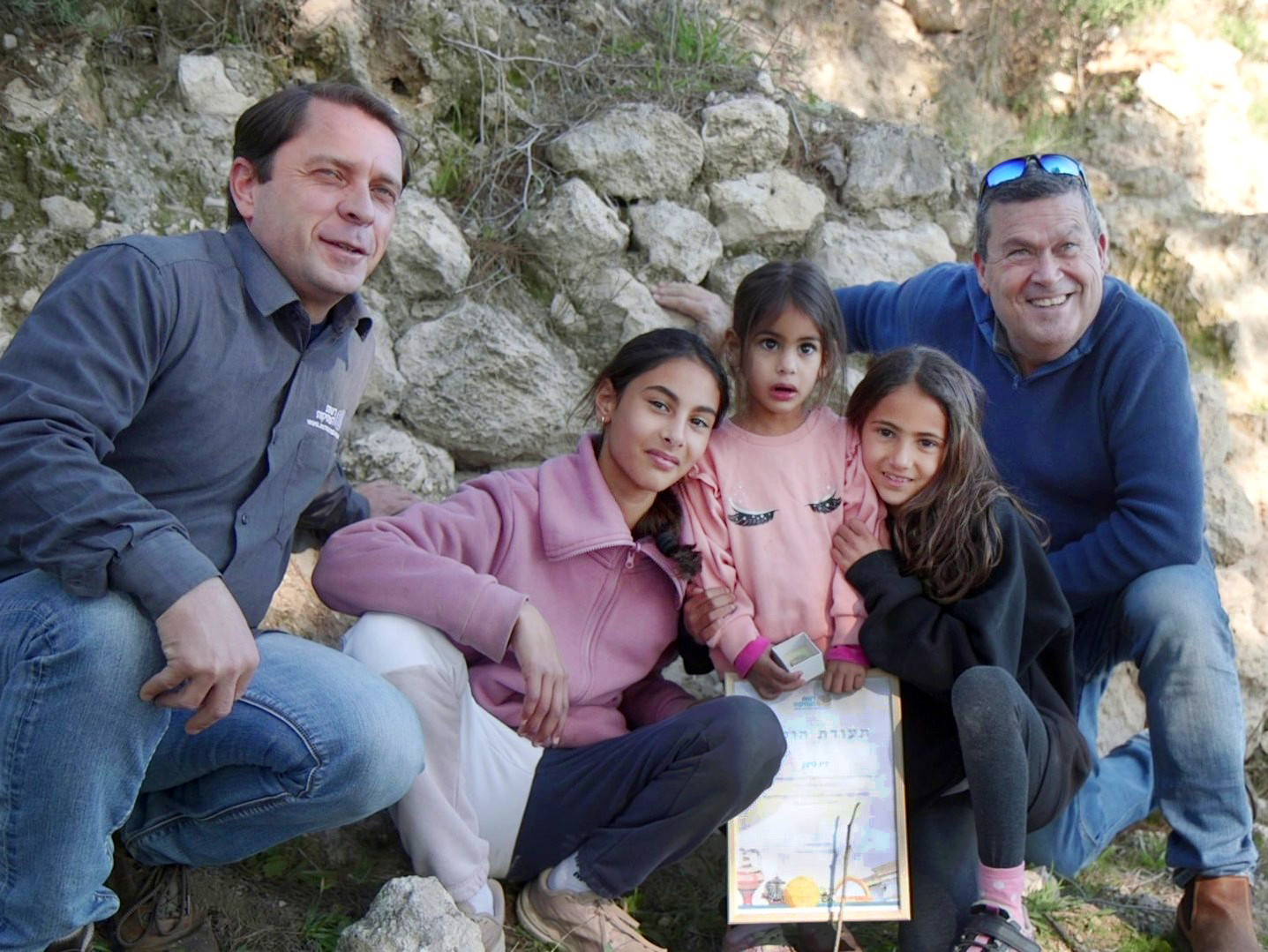In a remarkable archaeological discovery, 3-year-old Ziv Nitzan found an ancient scarab amulet dating back approximately 3,800 years while on a family outing at Tel Azeka, near Beit Shemesh, in early March.

Ziv Nitzan and her sisters with the certificate of appreciation. Photo by Emil Aladjem, Israel Antiquities Authority

The seal in the hand of 3.5-year-old Ziv. Photo by Emil Aladjem, Israel Antiquities Authority
“We were walking along the path, and then Ziv bent down – and out of all the stones around her, she picked up this particular stone,” recounted Omer Nitzan, Ziv’s sister. “When she rubbed it and removed the sand from it, we saw something was different about it. I called my parents to come see the beautiful stone, and we realized we had discovered an archaeological find! We immediately reported this to the Israel Antiquities Authority.”
The Israel Antiquities Authority was quick to recognize the significance of the find. Semyon Gendler, Judah Region District Archaeologist, praised the young girl and her family for reporting their discovery and presented Ziv with a certificate of appreciation for good citizenship.
Dr. Daphna Ben-Tor, an expert in ancient amulets and seals expert, identified the artifact as a Canaanite scarab from the Middle Bronze Age. “Scarabs were used in this period as seals and as amulets,” explained Dr. Ben-Tor. “They were found in graves, in public buildings and in private homes. Sometimes they bear symbols and messages, that reflect religious beliefs or status.”

Scarab seals are small ornamental objects that originated in ancient Egypt and were designed to resemble dung beetles. These beetles held sacred significance for ancient Egyptians as symbols of new life, due to their habit of creating dung balls in which they laid eggs, from which new life would emerge. The Egyptian name for the scarab derives from the verb meaning “to come into being” or “to be created,” reflecting the Egyptians’ view of the scarab as representing the incarnation of God the Creator.

The discovery site at Tel Azeka has considerable historical and archaeological importance. Professor Oded Lipschits, director of the Tel Aviv University archaeological excavation at the site, personally met with Ziv and her sisters at the tel. “We have been excavating here for almost 15 years, and the excavation findings show that during the Middle Bronze and Late Bronze Ages, here in Tel Azekah, thrived one of the most important cities in the Judean Lowlands,” said Lipschits. “The scarab found by Ziv joins a long list of Egyptian and Canaanite finds discovered here, which attest to the close ties and cultural influences between Canaan and Egypt during that period.”
The site has been excavated for 15 years by researchers from Tel Aviv University (TAU).

Tel Azekah – aerial view. Photo by Emil Aladjem, Israel Antiquities Authority
Tel Azeka is also known for its biblical significance as a key location in the battle between David and Goliath, as described in the Book of Samuel. According to the prophet Jeremiah, Lachish and Azekah were the last two Judean cities to fall before the conquest of Jerusalem.
Israeli Minister of Heritage, Amichai Eliyahu, commented on the significance of the find: “The seal that little Ziv found during a family trip to Tel Azekah connects us to a grand story, that of the ancient civilizations that lived in this land thousands of years ago. The scarab Ziv found also reminds us that in the Land of Israel, even children can be a part of discovering history.”
Eli Escusido, Director of the Israel Antiquities Authority, expressed gratitude to Ziv and her family: “Ziv, and her family, deserve praise for handing over the find to the National Treasures of the state of Israel. Thanks to her, everyone will be able to see it and enjoy it.”
The ancient seal will be featured in a special Passover exhibition organized by the Israel Antiquities Authority at the Jay and Jeanie Schottenstein National Campus for the Archaeology of Israel. The exhibition will showcase the scarab alongside other artifacts from the Egyptian and Canaanite periods, many of which will be displayed publicly for the first time.
“In honor of Passover, we will present the seal in a special exhibition set up by the Israel Antiquities Authority at the Jay and Jeanie Schottenstein National Campus for the Archaeology of Israel, alongside other findings from the Egyptian and Canaanite eras,” Escusido added. “In our public tours we will present impressive items for the first time, including seals of the pharaohs, Egyptian statues, ritual vessels, and evidence of the Egyptian cultural influence in the Land of Israel – and everyone is invited!”




